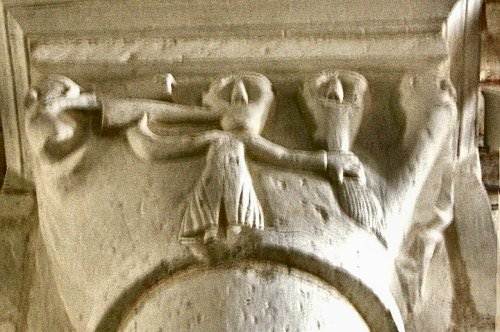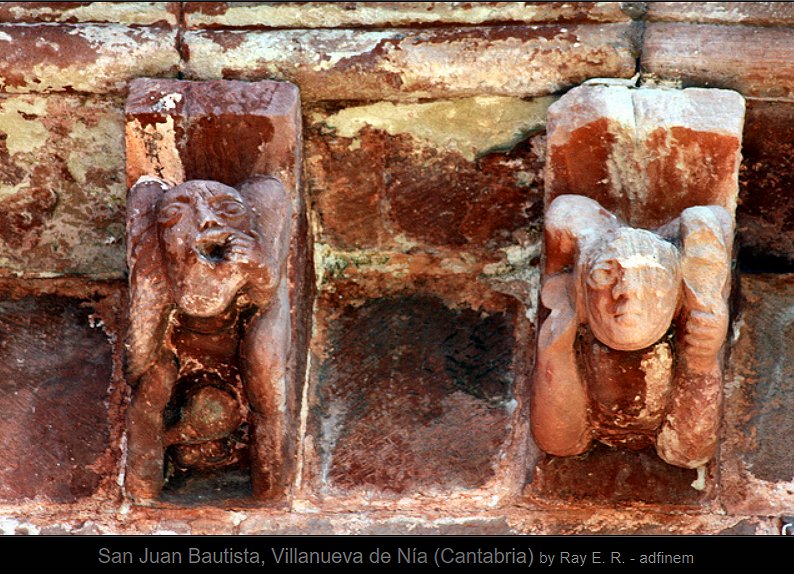HORNBLOWERS
A transept capital at Passirac (Charente) depicts a man afflicted by concupiscence
and being warned by heavenly hornblowers,
like those at Brioude.
.
Thirty years later...

photo © Joël
Jalladeau
Compare with this group of entertainers from San Martín de Mondoñedo (Lugo).
Two corbels at Moulins-sur-Yèvre (Cher)
where one figure sounds the Last Trump in the direction of a sinner being
devoured by the jaws of Hell...

...while at Lasvaux, Martel (Lot), the horn-blower blasts at a (broken)
megaphallic exhibitionist...

..and at Bourbon-l'Archambault (Allier) two hornblowers mounted
on rams
direct their blasts towards a devilish figure with raised skirts.

Other capitals in the same church feature heavenly musicians, including
another (bearded) hornblower
who simultaneously plays the harp while seated on a stool.

At Saint-Révérien (Nièvre), the dead arise from sarcophagi
as two angels sound the Last Trump.

But at Oyré (Vienne), the trumpeter simultaneously pulls the
long beard of a sinner.

remerciements à Joël Jalladeau pour les cinq photographies précédentes.
Compare again with the group at San Martín de Mondoñedo.

Yermo (Cantabria)
Hornblower.jpg)
Beaulieu-sur-Dordogne (Corrèze)

Santiago de Compostela, Puerta de las Platerías:
Adam and Eve with the Trumpeter of Doom beneath.
ú
A remarkable transept-capital in the Cantabrian church at Villanueva
de la Nía might be a lampoon
like the famous self-fellating bishop on Cologne Cathedral.
shows an important personage flanked by two exhibitionists - one almost
identical to the female on an outside window at nearby Cervatos,
the other a broken ithyphallic male blowing a trumpet into the ear of
the personage,
who stands with palms outstretched and wears a tiara of something resembling
hares' ears
(the hare was a symbol of concupiscence)
or possibly feathers as worn by (concupiscent) jongleurs/joglars - or
a King of Fools.


photos by courtesy of Mark Gredler

It should be remembered, however, that some early
and Roman horn-blowers represent winds,
as on the marvellous floor-mosaic in the chapel of St-Nicolas, Die
(Drôme),
where similar heads/masks spout the rivers of Paradise in familiar Romanesque style.
and on the wonderful 12th century Creation Tapestry at
Girona in Catalonia,
here showing the South Wind astride an enormous bellows.

bottom right: Eve emerging out of Adam, as Athene
did from the head of Zeus.
But the roughly-contemporaneous Beatus manuscript from the Escorial
shows the altogether less cheerful Second Trumpet of the Angel of
the Apocalypse,
causing the fiery mountain to fall into the sea.

Chrism with lovely
and significant decoration - including a horn-blower -
above the doorway at Coll de Nargo (Lleida).

This chap at Champagnolles (Charente-Maritime) might represent a wind.
Capital from the cathedral of Saint-Etienne in Toulouse:
a jongleresse with bells hanging from her tresses, and two
horns originally attached to her jaws!

This remarkable carving is on a 15th century Hindu temple at
Candi Sukuh on the island of Java, Indonesia.
The only purely Hindu element on it is the hair.
How did the Romanesque squatting exhibitionist (sometimes with the
horn
motif added)
reach the East Indies ?

________________


